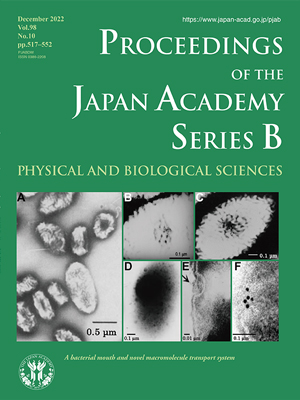About the Cover
Vol. 98 No. 10 (2022)
Is the mouth a special device for multicellular organisms? Does a mouth exist in unicellular organisms such as bacteria? Bacteria are in principle unable to directly incorporate macromolecules into their cells. They frequently excrete macromolecule-degrading enzymes externally from the cells and then incorporate the resulting low-molecular-weight products through specialized transport systems on their cell surface.
Electron microscopy revealed the following morphological observations; (i) The cells growing on alginate were of two types that always coexisted in the medium, which comprised cells with or without a pit on the cell surface (A). (ii) In an early stage of growth on alginate, a few tiny holes began to open near the center of the cell surface layer (B), increased in number, and, in association with the degradation of cell surface pleats, eventually developed into a pit (C). (iii) Alginate was concentrated in the pit (D). (iv) Thin sections of cells grown on alginate showed a specific region where the cell surface sank into the cells (E).
These lines of evidence confirmed the presence of not only a mouth (i.e. a pit) on the bacterial cell surface but also a novel macromolecule transport system. Alginate was concentrated in the pit mainly by the action of cell surface-localized flagellin, a flagella-forming protein, then transported into the cytosol through a tunnel-like structure created by the interaction of periplasmic solute-binding proteins and an ATP-binding cassette transporter, which were placed just below the pit (F), in the cytoplasmic membrane.
As far as we know, this is the first description of a pit-forming bacterium in the history of microbiology and it indicated that cell surfaces have numerous hidden possibilities to construct highly organized structures. How is such a huge structure (pit) formed? How is the pit formation process regulated to match with cycles of DNA replication and cell division, and when and why did flagellin acquire alginate-binding ability? These exquisite regulations of cell surface dynamics are central problems of biology to be addressed. The analysis of these cell surface events will undoubtedly lead to characteristic and innovative macromolecule processing biotechnologies and bioindustries.
Hidehiko Kumagai
Senior adviser of Ishikawa Prefectural University




